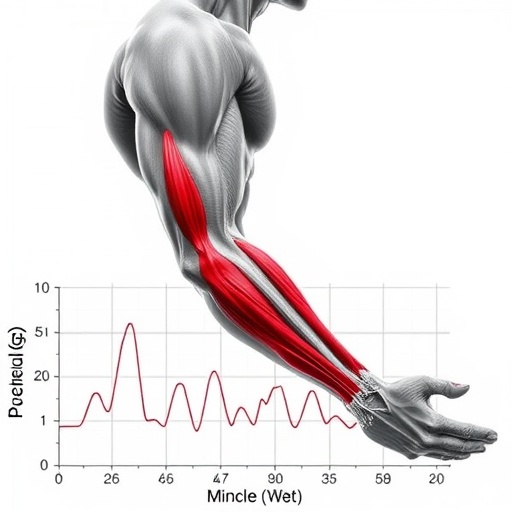In a groundbreaking study that delves into the intricacies of musculoskeletal dynamics, researchers have unveiled innovative methodologies to estimate muscle tendon passive parameters using sophisticated musculoskeletal optimal control techniques. The research, conducted by Ramezani, Dranetz, and Choi, promises to not only enhance our understanding of muscle-tendon mechanics but also catalyze advancements in biomechanical engineering, rehabilitation, and more.
The core objective of musculoskeletal research revolves around decoding the complex interactions between muscles and tendons during movement. These interactions play a vital role in both athletic performance and rehabilitation from injuries. By employing advanced optimal control algorithms, the researchers aim to provide precise estimations of passive parameters that govern muscle tendon behavior—an area that has often been fraught with challenges due to the intricate nature of musculoskeletal systems.
Motivated by the limitations of traditional models that often assume a linear relationship in muscle-tendon systems, the team developed a framework that accounts for the nonlinear characteristics inherent in biological tissues. This represents a significant shift in the paradigm of how muscle-tendon parameters are estimated, providing a more nuanced understanding that can adapt to the complexities of human anatomy and physiology.
By harnessing the power of optimal control, the research team was able to simulate various movement scenarios and collect real-time data pertaining to muscle and tendon responses. This approach not only allowed for the calibration of models but also provided a dynamic view of how passive parameters fluctuate under different loading conditions. The implications of these findings could extend to the design of prosthetics and orthotics, improving their functionality by mirroring true biological responses more closely.
Importantly, this study emphasizes the necessity of accurate passive parameter estimations in musculoskeletal models to ensure that simulations reflect real-world conditions. Inaccuracies in these estimates can lead to flawed predictions, adversely affecting applications ranging from injury prevention strategies to performance enhancement in athletes. The involvement of a multidisciplinary team underlines the collaborative nature of the research, bringing together expertise in biomechanics, engineering, and clinical practice.
The researchers utilized a robust experimental framework that integrated high-fidelity motion capture with biomechanical analysis. This combination enabled them to examine how muscles and tendons behave not just in isolated movements but in coordination with one another during complex movements, akin to those seen in everyday activities. The data gleaned from these analyses were invaluable in refining the optimal control algorithms, allowing for a higher resolution in predicting muscle-tendon interactions.
The outcomes of this research possess significant ramifications for the field of rehabilitation. With precise mappings of how muscle and tendon parameters operate, therapists could develop highly personalized rehab protocols tailored to individual patients’ needs. This could enhance recovery rates and improve functional outcomes for individuals recovering from musculoskeletal injuries, ultimately leading to better quality of life.
Moreover, this study sheds light on the potential for advancements in robotic applications. As the industry shifts towards integrating biomechanical insights into robotic designs, the estimation of passive parameters could play a pivotal role in creating robotic limbs or exoskeletons that work harmoniously with human movements. Such innovations could revolutionize safety and efficiency in various physical tasks, from industrial settings to assistive technologies for those with mobility impairments.
In terms of future directions, the authors suggest that their methodologies could be applied to a broader range of conditions and activities. For instance, investigating how aging affects muscle-tendon dynamics or how specific sports impact these parameters could provide further insight into musculoskeletal health across the lifespan. There is an added potential to use this knowledge in preventing injuries in high-risk populations, particularly in sports and occupational settings.
Furthermore, the study opens avenues for improved techniques in digital modeling. As researchers continue to incorporate machine learning and artificial intelligence into biomechanical research, the methodologies established in this work could serve as foundational frameworks, allowing for the synthesis of vast datasets that can reveal worker-specific or situation-specific tendencies in muscle-tendon behavior.
The significance of this research cannot be overstated. As the landscape of biomedical engineering continues to evolve, studies like this one pave the way for a future that merges technology with our understanding of human biology. The integration of optimal control in musculoskeletal parameter estimation is a testament to the strides being made in this field, promising a richer and more comprehensive perspective on how we move and interact with our environment.
In summation, the estimations of muscle tendon passive parameters using musculoskeletal optimal control form a critical step toward not only enhancing our comprehension of human biomechanics but also innovating practical applications in healthcare, rehabilitation, and robotic engineering. Through ongoing research and development, this area of study holds immense potential, promising to shape the future of movement sciences.
As we move towards a future where the interplay of technology and biology becomes increasingly seamless, the commitment of researchers to unravel the complexities of musculoskeletal systems will undoubtedly lead to transformative advancements. The collaborative spirit exhibited in this study serves as a powerful reminder of the possibilities that lie ahead in the realm of biomedical engineering and musculoskeletal research.
Subject of Research: Estimation of muscle tendon passive parameters using optimal control techniques in musculoskeletal systems.
Article Title: Muscle Tendon Passive Parameter Estimation Using Musculoskeletal Optimal Control.
Article References:
Ramezani, S., Dranetz, J. & Choi, H. Muscle Tendon Passive Parameter Estimation Using Musculoskeletal Optimal Control.
Ann Biomed Eng (2025). https://doi.org/10.1007/s10439-025-03874-0
Image Credits: AI Generated
DOI: 10.1007/s10439-025-03874-0
Keywords: musculoskeletal dynamics, muscle-tendon interaction, optimal control, rehabilitation, biomechanics, parameter estimation, injury prevention, robotics, personalized protocols, machine learning.




